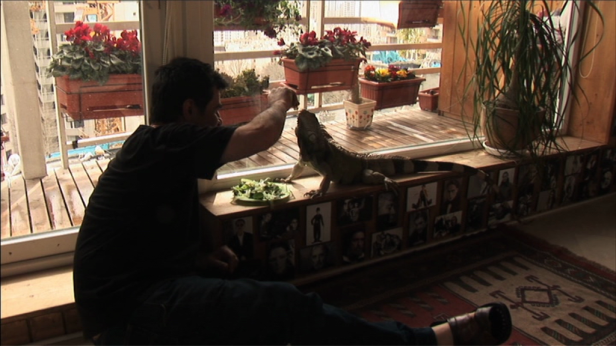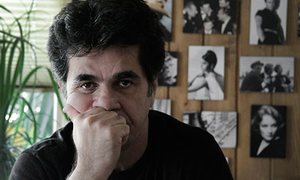‘This Is Not A Film’ is actually a film. But it is a particularly unusual one.
The film – for it is one – traces a day in the life of Jafar Panahi, one of a welter of acclaimed contemporary Iranian film directors. The day we follow is a typical one for him, but will leave the audience both bewildered and outraged over his situation. Panahi spends his day, roaming and pacing his flat, facing a possible 20 year ban on film-making and 6 year imprisonment, along with a restriction from leaving the country.
From the start I shall hold my hands up and admit that I lack any knowledge of Jafar Panahi and his work. However, that is the key reason why This Is Not A Film is such a joy. After just 75 minutes, the audience knows this man, his personality, and the kind of films he makes, and develops a strong attachment to him through his creative, and legal, struggles.
A quick – but important – side note. To avoid actually being ‘directed’ by Panahi, This Is Not A Film is listed jointly as ‘an effort by Jafar Panahi and Mojtaba Mirtahasebi’. Whilst it is Mirtahasebi who is behind the camera, with Panahi in front, there is no doubt who the creative force is.
An additional, quick – but amusing – side note. So wary of having the film seized by the authorities and further punishment being handed down, the film had to be smuggled out of the country on a USB drive, hidden inside a cake.

Back to the film itself, through the day we witness him plotting his next film (interrupted intermittently by his pet iguana, which also paces and roams the flat). While not able to direct films any longer, he is still allowed to write them (even if all screenplays he writes must be submitted to ‘The Ministry’). He wants to tell the story of a teenage girl who dreams of going to university to study, but is prevented by her family from her leaving home. It is clearly a passion project for him, with clear echoes of his own life: the story of an innocent individual, trapped in their circumstances, unjustly prevented from fulfilling their creative and intellectual potential.
He plots out the film, scene by scene, on the Persian rug on his floor, moving around, acting scenes out, delivering characters’ lines. It has become evident instantly that Panahi is a man who loves cinema, loves the history of cinema, and most of all, loves making cinema. His walls are covered in postcards of directors.

But something becomes all too cruelly clear to Panahi: “If you could tell a film, then why make a film”. Why go to all the effort of explaining the plot to camera, when it will never match the final product. A final product which he will never be allowed to make. The story can never be satisfactorily told. It is a moment of tragic realisation for him.
Related to this is a second cinematic truth that he reveals: “The film must be made firstly, to be explained later”. Panahi loves the unexpected events that happen on camera, or on a set, that even the perfect auteur cannot plan. A film cannot be thought into existence. It needs to be made.
A perfect example comes later in this very film. One of Panahi’s neighbours in the apartment block asks if Panahi can look after his dog. Panahi is not keen on the idea, takes the dog into his apartment for only about 30 seconds, before calling his neighbour back – the dog was about to savage his iguana. Then, later in the film, a third individual – within earshot of Panahi and the camera – suggests to the man that Panahi look after his dog, with no idea of the conversation earlier in the day. It is a moment of absolutely nothing. Of boring small-talk. Yet that small coincidence shows that, in cinema, it can be in the miniscule, accidental details in which a film can have its most affecting moments.
Panahi’s meeting with this third individual also reveals something important about his character. He has a desire to know other people’s life stories, however ‘mundane’ they appear to themselves. Panahi wants to learn about people and their experiences, stories of ‘ordinary’ or ‘normal’ lives, and tell them as the dramatic and moving course of events that they actually are. It is incredibly unusual to see an individual who does not just wish to end a conversation with a stranger as soon as it starts. Or maybe that’s just the UK …
The second half of the film (because it is indeed a film) raises a further philosophical question, of what a film actually is. Outside his apartment there are New Year firework celebrations (the police are also trying to crack down on these). Panahi picks up his phone and starts to film them. Is this directing a film? Is it breaking the law?

Regardless of whether it is or not, it is clear that he has an innate reaction to pick a camera up. Earlier in the film he showed the audience a behind-the-scenes clip from a film he made years before. His child actress got bored, and stormed off set. Rather than halt filming for the day, he encouraged his cameraman to follow her and keep filming. His desire to film everything is evident throughout. A desire he is now prevented from fulfilling by an arbitrary authority.
This review – as a lot of reviews generally do – has fallen exactly into the trap that Panahi lays out. I have tried to ‘tell’ a film – an invariably insufficient process. This Is Not A Film is a film, and it is a film that needs to be watched.
